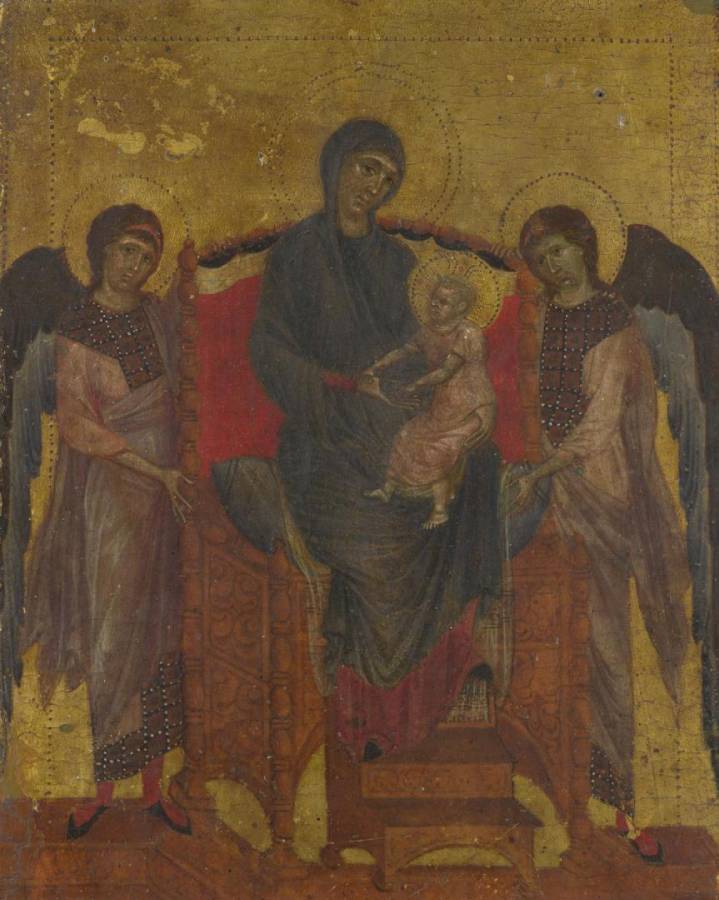Cimabue (1240-1302)
Maestà con due angeli (The Virgin and Child with Two Angels)
c.1280–1285
Egg tempera on wood, 25.6 × 20.8 cm
National Gallery, London
This is one of the earliest paintings in the National Gallery’s collection and a rare surviving work by Cimabue. Until this work was rediscovered in 2000, Cimabue was known only for large-scale works including frescoes, painted crucifixes and monumental images of the Virgin and Child enthroned.
Cimabue was working at a time when Italian artists were adopting and adapting images and motifs from the religious art of the Eastern Christian empire, Byzantium. Cimabue transformed these traditionally formal images into representations that were more accessible to Western Christians who were concerned with developing a personal relationship with God. His experiments with three-dimensional settings and gesture were highly influential on the next generation of Italian painters such as Giotto.
The Virgin Mary is seated on a wooden throne, holding the infant Christ on her lap. The cushion beneath her curls up slightly at the edges, giving an impression of their weight. This, along with the three-dimensional structure of the throne, creates a sense of real presence before a worshipper.
Two angels with long feathered wings present the Virgin and Child to the viewer, gripping the throne with their slender fingers. They wear red and white headbands, red stockings and black shoes. Between their pink tunics and pale purple robes are decorated strips of brown fabric studded with pearls. These decorated bands resemble the loros – an embroidered and jewel-studded textile that was part of the ceremonial costume of the emperors and empresses of the Byzantine Empire. Cimabue uses the visual language of earthly power to reflect the Christian idea of the Virgin and Christ as the Queen and King of Heaven. The entire image is comparable with a Byzantine prototype where the angels are identified as the archangels Michael and Gabriel.
The Christ Child grabbing at his mother’s hand, as any baby might, creates an intimate image of motherhood. The image also has a complex message to aid the devotions of the viewer: while Christ is absorbed in this activity the Virgin and the angels look towards the viewer, with whom they share a knowledge of Christ’s divine nature and his fate as an adult. The cloth on which the Virgin is seated, with its decorated border, also hints at Christ’s suffering and death. It resembles the kind placed upon an altar used to bless the bread and wine of the Eucharist, shared by Christians at Mass in commemoration of Christ’s death and renewal of their faith.
The panel is damaged at the left and upper edges, most likely due to the removal of a frame. The other edges remain intact, with painted red borders. This suggests that it was framed together with a number of other scenes, painted on the same piece of wood and separated from one another by red lines, either as a single devotional panel or possibly as a dossal. Alternatively, the panel might have been cut from a diptych, composed of two panels depicting various scenes from the Passion of Christ. After the National Gallery bought the work, it was connected with another of equal scale at the Frick Collection, New York, which shows the Flagellation. In 2019, a further picture depicting The Arrest of Christ, which is also the same size and which clearly relates to the same series, was discovered in a private collection in France and is now in the Musée du Louvre, Paris. As a group, the panels allow, for the first time, for an appreciation of how Cimabue applied his innovations in transforming Byzantine models for Western Christians on a small scale. (NG)
